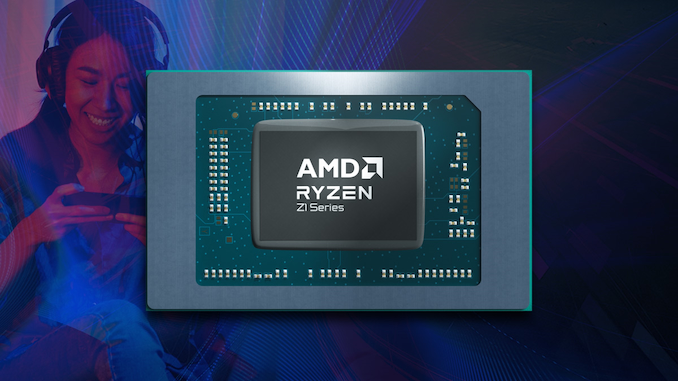AMD has introduced the Ryzen Z1 sequence of high-performance processors for handheld PC gaming consoles. The most recent Ryzen Z1 chips wield Zen 4 cores and RDNA 3 graphics, a well-known mixture that AMD makes use of for its present cell Ryzen 7040HS sequence (Phoenix) processors. And whereas the chipmaker hasn’t formally introduced any decrease energy Phoenix chips but (e.g. Ryzen 7040U sequence), given the similarities within the characteristic set of the Ryzen Z1 household and the Phoenix silicon, the Ryzen Z1 sequence seems to be a custom-tailored Phoenix SKU that prioritizes vitality effectivity for handheld gaming gadgets. The lead buyer for the Ryzen Z1 can be Asus, who can be utilizing it of their upcoming ROG Alloy.
The Ryzen Z1 sequence is being launched with two SKUs. The highest-tier Ryzen Z1 Excessive has eight Zen 4 CPU cores – the utmost discovered on Phoenix – whereas the vanilla Ryzen Z1 cuts that down to 6 CPU cores. In the meantime, on the graphics aspect of issues, the Ryzen Z1 Excessive flaunts 12 RDNA 3 structure compute models, once more aligning with the max quantity discovered on Phoenix silicon. Its vanilla Z1 counterpart, however, will ship with simply 4 CUs enabled, one-third as many as on the flagship half.
Each chips profit from a 16 MB L3 cache, whereas the Ryzen Z1 Excessive has 2 MB extra L2 cache resulting from its extra CPU cores. In any occasion, the Ryzen 1 and Ryzen Z1 Excessive possess sturdy computing efficiency due to the excessive CPU core depend and the utilization of AMD’s newest Zen 4 cores. A hexa-core processor ought to suffice for handheld gaming, and both Ryzen Z1 processor will definitely outperform AMD’s older {custom} quad-core Zen 2 SoC (Aerith) that powers Valve’s Steam Deck.
| AMD Ryzen Z1 Specs | ||||||||
| AnandTech | Cores Threads |
Base Freq |
Turbo Freq |
L2 Cache |
L3 Cache |
GPU | TDP | |
| Ryzen Z1 Excessive | 8/16 | ? | ? | 8 MB | 16 MB | 12 RDNA 3 CUs | 15 – 30 W | |
| Ryzen Z1 | 6/12 | ? | ? | 6 MB | 16 MB | 4 RDNA 3 CUs | 15 – 30 W | |
{Hardware} unit counts apart, AMD is not revealing the clock speeds for the 2 4nm processors. Curiously, an embargoed report printed by The Verge has quoted “as much as” 8.6 TFLOPS and a pair of.6 TFLOPS graphics efficiency, respectively, based mostly on AMD’s engineering projections. However these figures have been faraway from the deck AMD has since been sending round to the remainder of the press. If these figures do change into moderately near what the ultimate transport silicon can hit, then that may imply we might be taking a look at peak GPU clock speeds of round 2.8 GHz and a pair of.6 GHz, respectively, which is only a bit decrease than what the Ryzen 7040HS chips run at.
The Ryzen Z1 sequence chips will assist a most TDP of 30 Watts, which occurs to be the identical high energy goal as AMD’s cell Ryzen U-series chips. In the meantime, though this wasn’t in AMD’s press deck or press launch, AMD’s Ryzen Z1 product web page lists a minimal TDP of 15 Watts. Although it is value noting that, in contrast to TDP maximums, TDP minimums will not be a tough ground or ceiling for cell processors. Chips will be configured to run even much less when it is known as for, relying on what the shopper needs.
Simply to supply a comparability right here, Aerith’s TDP is between 4 Watts and 15 Watts, which means the Z1 sequence actually gives a great deal bigger energy vary for purchasers to play with. At its high TDP, such a configuration would shortly blow by way of the battery in any handheld machine, however for docked gadgets, it’s extremely possible. As for handheld mode, it is extra possible that we’ll see Z1 chips clocked comparatively low to preserve valuable energy.
Being that that is an AMD product designed for PC-like gadgets, it has entry to all AMD graphics applied sciences, together with Radeon Chill, which helps enhance battery life by adjusting body charges based mostly on the actions within the sport. This additionally implies that FSR can be on the desk on a game-by-game foundation, and RSR as a much less optimum common answer.
AMD supplied some benchmarks for the Ryzen Z1 sequence using the Asus ROG Ally. As normal, throw a pinch of salt over vendor-provided benchmarks. The machine used right here additionally had 16 GB of LPDDR5 reminiscence and a Micron 500 MB SSD. It is necessary to spotlight that AMD put the Asus ROG Alloy in turbo mode for its benchmarks, which implies that the Ryzen Z1 sequence processors have been working at energy ranges of as much as 30 Watts.
AMD’s outcomes present the Ryzen Z1 Excessive delivers common body charges above 60 FPS in most titles. Nonetheless, the chipmaker examined with the bottom settings at a mixture of 1080p and 720p upscaled with RSR to hit these figures. The Ryzen Z1’s efficiency wasn’t unhealthy, however the two chips’ delta was perceptible. The distinction spans between 6% and 73%. Zen 4-based processors took a major efficiency hit at native 1080p decision on the bottom settings. As anticipated, the Ryzen Z1 struggled in a number of titles and did not hit the 60 FPS mark.
Asus has first dibs on the Ryzen Z1 sequence; nonetheless, extra rivals powered by the 4nm Ryzen Z1 chips ought to arrive down the highway. Asus’ ROG Ally would be the first handheld gaming console to characteristic AMD’s Ryzen Z1 Excessive processor, with the corporate set to share extra info on the hand-held (together with pricing) on Might 11.
Supply By https://www.anandtech.com/present/18829/amd-releases-ryzen-z1-series-zen-4-and-rdna-3-come-to-handheld-game-consoles






